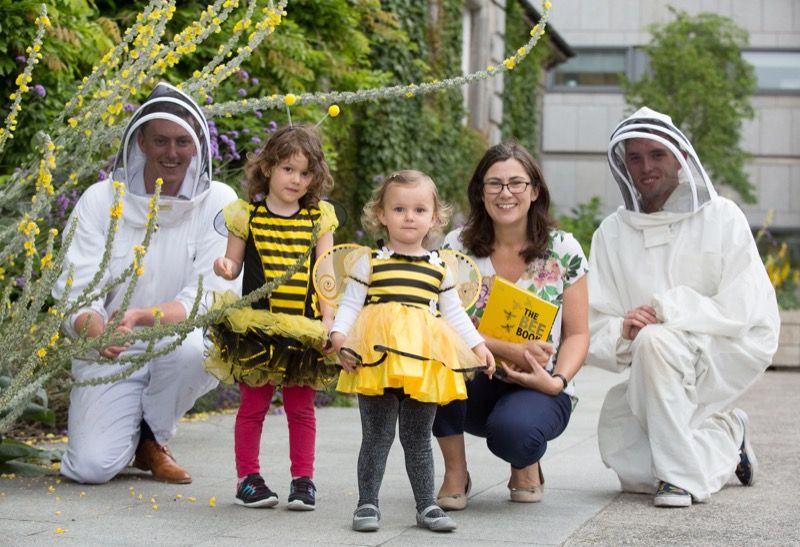Trinity welcomes Queen Medb as public names our campus VIP
Posted on: 07 July 2017
Trinity College Dublin is proud to present ‘Queen Medb’ — a Royal VIP charged with leading thousands of honeybees — after her name was selected from the hundreds of suggestions that flooded in from people across the globe in response to a social media competition that had biologists and bee-lovers abuzz.
Back in April, a four-week competition run via Trinity’s websites and social media streams asked the public to come up with a fitting name for the queen bee of its newly installed campus beehive. The response was fantastic, with hundreds of people sending in their suggestions – some weird, some wacky and some wonderful – from over 20 different countries around the world.

Some popular suggestions were Beeyonce, Barry B. Benson, the star of Bee Movie, and Bee McBeeFace, with people no doubt inspired by the ‘Boaty McBoatFace’ story from 2016 that saw the public vote for that as the name of a research vessel owned by the Natural Environment Research Council in the UK. Other suggestions of note for Trinity’s queen bee included Beelizabeth, Melissa (Greek for honey bee), (Royal) Tara, Polly(nator), HoneyComber McGregor, Fódla (Irish goddess), Trinibee and Beeram Stoker.
But ‘Medb’ proved to be the winning name, with a panel comprising Trinity staff, students, beekeepers and Professor in Botany, Jane Stout, feeling that Trinity’s first queen bee should be named after Queen Medb, a strong female leader in old Irish mythology. ‘Medb’ was suggested by a handful of people, and Dublin resident Cormac McMullan was randomly selected as the winning entrant from those.
While the competition to name Trinity’s queen bee was intended to be light-hearted, it also offered a brilliant opportunity to engage people with pollinator facts (see below, and the series of ‘postcard’ images) and enlighten them about the importance of the ecosystem services that bees and other insects provide.
Professor Stout said: “I am delighted with the responses we received and that our queen bee is named after Queen Medb: the name is said to mean 'she who intoxicates', which is fitting as the queen bee produces a chemical that supresses egg-laying in the worker bees in the hive; and the name has the same roots as the English word 'mead', which is a drink made from honey.”
“Our queen will produce tens of thousands of eggs during her life time, and her daughters will look after their sisters and brothers, clean the hive and collect the food for the colony. Although bumblebees have a similar life history, they produce fewer offspring and have smaller colonies (of up to a couple of hundred bees rather than thousands). But 77 other Irish bee species are solitary, meaning they don’t form colonies: the female lays her eggs and provides pollen for her young to feed on, but she then leaves them to it”.
“Protecting all these bee species is important as different species do things slightly differently, and together they can complement each other. For example, honey bees often approach apple flowers from the side, accessing the nectaries laterally, whereas other bees approach flowers from the top – and this influences how much pollen is picked up and deposited on the flowers, and thus the pollination and fruit formation in the apple. The goal of the All-Ireland Pollinator Plan, and the Trinity Campus Pollinator Plan, is to enable all bees and other pollinators to survive and thrive.”
Did you know? 15 interesting pollinator facts
- Insect pollination is worth at least 153 million euro/year to the global food crop industry
- 7 out of 8 of the world’s plant species are pollinated by animals
- There are 98 bee species in Ireland
- 1/3 of Ireland’s bee species are threatened by extinction
- Up to 60,000 honey bees can live in one colony
- Honey bees have two stomachs – one digests food, one stores nectar for the hive
- Honey bees fly 90,000 km to make one jar of honey
- Unfertilised honey bee eggs become (female) workers, whereas fertilised eggs become (male) drones
- A drone (male) honey bee does not have a father – but it does have a grandfather
- One hive of honeybees can produce over 25 kg of honey in a good season
- Just 1 oz of honey would fuel a ‘round-the-world’ trip for a bee
- Humans have eaten honey for thousands of years, since ancient Egyptian times
- A bee beats its wings about 200 times per second
- Some flowers have evolved ‘nectar guides’ that only insects can see
- Wildflowers are an important nectar source for a host of pollinators
How you can help Ireland’s bees
The All-Ireland Pollinator Plan
The All-Ireland Pollinator Plan is a an action plan to make Ireland pollinator-friendly – everyone can do their bit and all efforts, no matter how small, can help to create an island where bees and other pollinators can survive and thrive. The Plan and lots of guidelines and other resources can be downloaded from www.biodiversityireland.ie/pollinator-plan. Some suggestions include:
- Manage your garden in a pollinator-friendly way:
- http://www.biodiversityireland.ie/projects/irish-pollinator-initiative/all-ireland-pollinator-plan/gardens/)
- Encourage your business to become an official supporter of the All-Ireland Pollinator Plan: http://www.biodiversityireland.ie/projects/irish-pollinator-initiative/all-ireland-pollinator-plan/businesses/
- Get involved with local community initiatives to support pollinators, e.g. through ‘Tidy Towns’: http://www.biodiversityireland.ie/projects/irish-pollinator-initiative/all-ireland-pollinator-plan/local-communities/
- Encourage your child’s school to take actions for pollinators – a junior version of the plan (in both English and Irish): http://www.biodiversityireland.ie/projects/irish-pollinator-initiative/all-ireland-pollinator-plan/schools/
Citizen Science
And if you want to contribute to research to ensure that the best actions are implemented, become a citizen scientist!
Trinity College Dublin researchers are assessing floral resources for bees in Ireland – you can help by visiting: https://www.zooniverse.org/projects/eileenfranklin/count-flowers-for-bees and counting flowers for bees.
This article features in the summer 2017 edition of the Provost’s ezine, TRINITY NOW.
